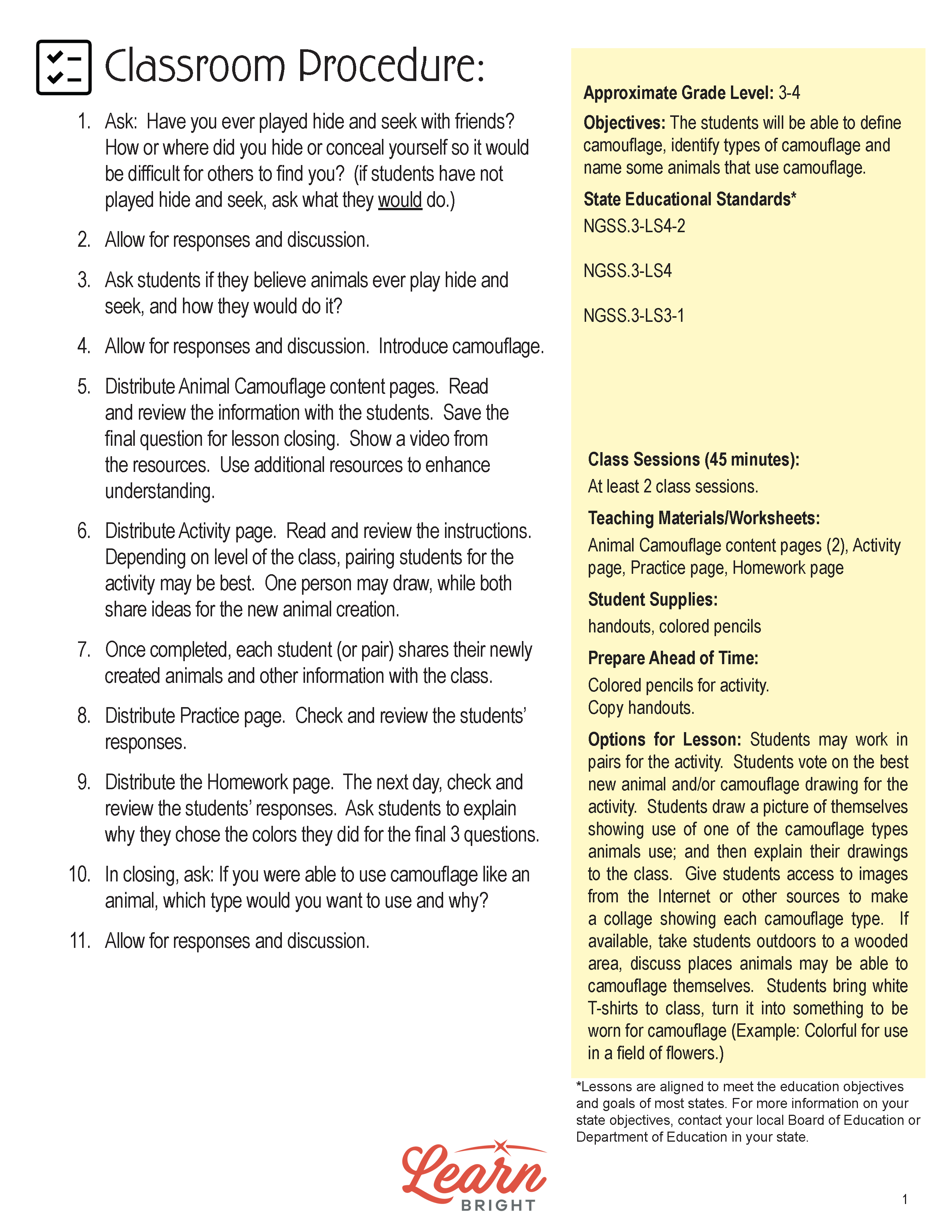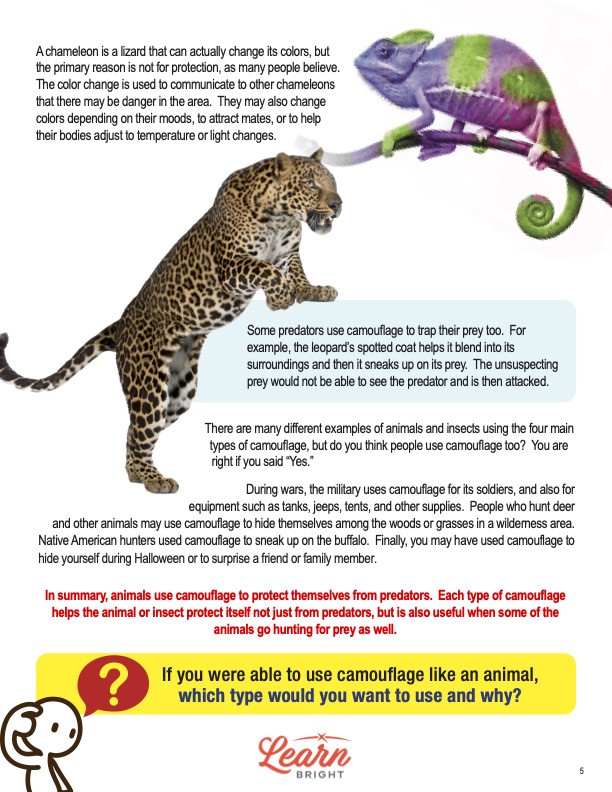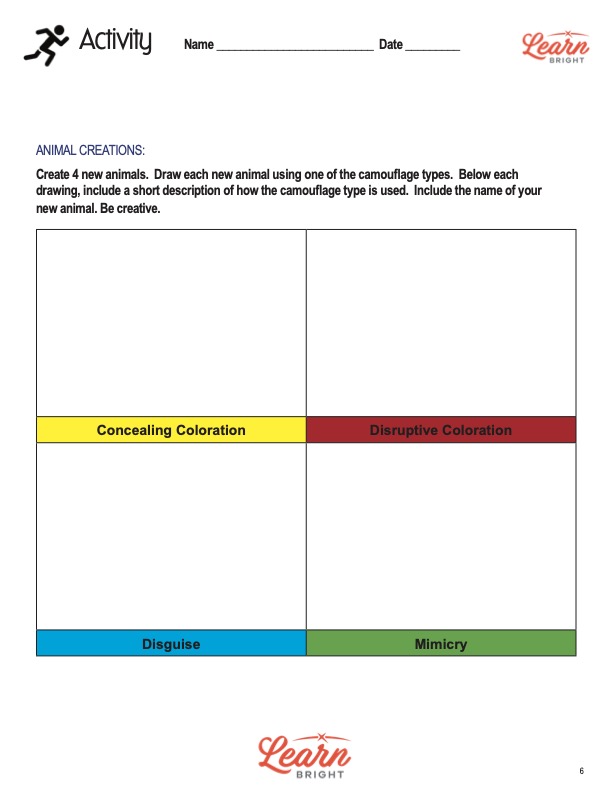Description
What our Animal Camouflage lesson plan includes
Lesson Objectives and Overview: Animal Camouflage teaches students about the many ways different animals adapt physically to their surroundings. Students will also discover why animals often have to adapt. They will learn to identify different types of camouflage. In addition, they will be able to describe some of the animals that adapt in these ways. The lesson is for students in 3rd grade and 4th grade.
Classroom Procedure
Every lesson plan provides you with a classroom procedure page that outlines a step-by-step guide to follow. You do not have to follow the guide exactly. The guide helps you organize the lesson and details when to hand out worksheets. It also lists information in the yellow box that you might find useful. You will find the lesson objectives, state standards, and number of class sessions the lesson should take to complete in this area. In addition, it describes the supplies you will need as well as what and how you need to prepare beforehand. You will only need to supply colored pencils in addition to the handouts for this lesson.
Options for Lesson
In this section of the classroom procedure page, you will notice a number of ideas for either additional activities or alternative suggestions for the lesson. For the activity, you could have students vote on the animal or camouflage drawing that they believe is best. Another idea is to have students draw a picture of themselves using one of the types of camouflage. You could also give students images from various sources to make a collage that displays all the camouflage types. If possible, another idea is to take students outdoors to a wooded area and discuss which animals around them might be able to camouflage themselves. A final idea is to have students bring white t-shirts to class and turn them into something that they could wear to camouflage themselves in a certain setting.
Teacher Notes
The paragraph on the teacher notes page provides a little more guidance. It suggests you take advantage of students’ curiosity about animals and teach other animal-related lesson plans at the same time. You can use the blank lines on this page to write down any other ideas or thoughts you have for the lesson.
ANIMAL CAMOUFLAGE LESSON PLAN CONTENT PAGES
What Is Camouflage?
There are three content pages in the Animal Camouflage lesson plan. The lesson introduces this concept by comparing it to hide and seek. When people play hide and seek, they try to hide so the person seeking cannot find them. Animals do something similar to hide and seek, and doing so is essential to their survival.
Students will learn that many animals use camouflage to protect themselves from their various predators in the wild. They cannot simply hide under a table or in a closet. Without camouflage, they would be in great danger. At the same time, certain animals benefit from camouflage when they hunt their prey. So prey use it to hide, and predators use it to seek.
There are four basic types of camouflage animals use to survive in their various environments. One is concealing coloration, which people sometimes refer to as blending. The snowy owl and polar bear use this type. Another is disruptive coloration, or patterning. Students can think of zebras or leopards as examples of this type. Next is disguise, which is the type used by walking stick insects and katydids. Finally, there is mimicry, which monarch butterflies and elephant hawk caterpillars use. The lesson details more about each of these types.
Types of Camouflage
The first type students will learn about is concealing coloration or blending. It gets it name because the animals who use this type to blend in to their surroundings. It helps animals hide themselves against a background of the same color. This is how snowy owls and polar bears blend in in the Arctic. Other animals who blend in include the green tree frog and the adult white-tail deer, which can blend in with trees or with the earth-tone colors of its environment respectively.
Next is disruptive coloration or patterning. Patterning helps break up the outline of an animal. Animals with spots, stripes, or other patterns can benefit in such a way that they don’t stick out against a background. Or it can help some animals stand out as a warning to a predator. Zebras use their stripes to avoid predators like lions who, being color blind, cannot make out a single zebra among all the others. Leopards’ spotted coats help them camouflage in tall brush or grasses as they hunt. There are some species of fish that use their patterns to stand out in a group.
Students will then learn about disguise. Animals that use disguise basically look like something else. An insect, for instance, might look like a stick, branch, or leaf. Its predators, then, may think it actually is a stick or leaf. Walking stick insects look like sticks, katydids look like leaves, and thorn bugs look like thorns on a plant.
Mimicry is the last type of camouflage students will learn about. Mimicry is a method some animals use in which they appear like other dangerous, bad tasting, or poisonous creatures or organisms. Animals pretend to be another animal or insect to fool their predators. The elephant hawk caterpillar has two false eyes, and it moves its head to look like a snake. The scarlet king snake and monarch butterflies are not poisonous, but they appear like species that are, which fools their predators.
Interesting Facts
After learning about the specific types of animal camouflage, students will learn some facts about specific animals and how they use camouflage. The lesson first reminds them that both predators and prey use this form of adaptation to survive in their environments.
For a lion to find a single zebra in a group is highly difficult. It cannot see a single zebra; it just sees a black and white background. This is because all of the zebras’ stripes make the group look like one big animal rather than many smaller ones. A chameleon is a lizard that can actually change colors. The primary reason is not for protection, as many people believe. Instead, it changes color to communicate different things to other chameleons. They might change to notify others that there is danger in the area, to attract mates, or to help their bodies adjust to temperature or light changes.
The lesson points out that people use camouflage in specific situations as well. For instance, during wars, military personnel use camouflage in their clothing, their tents, their vehicles, and other supplies. Native American people would use camouflage to sneak up on buffalo, similar to how hunters wear camouflage to blend in to their surroundings.
Key Terms
Here is a list of the vocabulary words students will learn in this lesson plan:
- Camouflage: a method of adaptation by which animals can hide themselves in some way
- Concealing coloration: the blending method of camouflage in which an animal’s colors allow it to blend in to its surroundings
- Disruptive coloration: the patterning method of camouflage in which an animal’s coloring has patterns that disrupt its outlines or helps it stand out
- Disguise: the method of camouflage in which an animal looks like another object
- Mimicry: the method of camouflage in which an animal appears dangerous, bad tasting, or poisonous when it actually is not
- Predator: the animal that hunts for other animals
- Prey: the animal that other animals hunt for
ANIMAL CAMOUFLAGE LESSON PLAN WORKSHEETS
There are three worksheets in the Animal Camouflage lesson plan: an activity, a practice worksheet, and a homework assignment. Each one will help students solidify their grasp of the things they learned throughout the lesson. You can look at the guidelines on the classroom procedure page to know when to hand out the worksheets to your students.
CREATE YOUR OWN ACTIVITY WORKSHEET
You may have students work in small groups or in pairs for this activity. Students will create four new animals, one for each of the four camouflage types. They can use scratch paper to practice drawing and then use the worksheet for the final draft. Students must also include a short description of how each animal uses the type of camouflage it represents.
WHICH TYPE PRACTICE WORKSHEET
For the practice worksheet, students will read through 16 statements. They must decide which type of camouflage the statement refers to. They will use each of the four types four times each.
ANIMAL CAMOUFLAGE HOMEWORK ASSIGNMENT
The homework assignment is split into three sections. On the first section, students will match five words from a word bank to the statement they represent. For the second section, students will read eight statements and decide whether they represent concealing coloration (CC), disruptive coloration (DC), disguise (D), or mimicry (M). The final section requires students to answer three questions.
Worksheet Answer Keys
The document has two pages at the end that provide answers for the practice and homework worksheets. For both worksheets, the answer keys provide the correct responses in red. For the homework assignment, students’ responses for the final section may vary slightly from those on the answer key, especially for the final question that is more open-ended. If you choose to administer the lesson pages to your students via PDF, you will need to save a new file that omits these pages. Otherwise, you can simply print out the applicable pages and keep these as reference for yourself when grading assignments.










